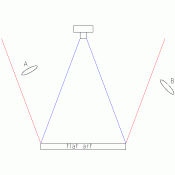You can probably avoid the need for polarization altogether if your lighting setup is well done. Set up the art and camera square and centered. Note that as in the accompanying drawing, the camera sees the canvas covering a certain angle (blue lines). Take the angle of reflection, equal to the angle of incidence, and you get the two wider red lines coming back off the edges of the artwork. A light source at position "A", located inside the family of angles (red lines) within which the camera can see a direct reflection off the artwork, will cause a direct reflection within the artwork (unless it's a very diffuse surface). A light placed at position "B", outside the family of angles that get reflected, cannot cause direct reflections off the artwork (except over small areas if heavily textured and reflective). Note that a wider angle lens placed closer to the art has a wider family of angles, so the lights would need to be at greater angles from the lens-to-art axis. A longer lens placed further away from the art has a narrower family of angles and allows a greater range of safe light placement. So if you place your lights, including the entire lit surface of the diffusers, outside the family of angles (the red lines) and with even illumination across the artwork, you should be good.
You might also want gobos to keep direct light off the lens and reduce flare. A dark background (cloth, paint, seamless paper) also helps prevent flare and distracting shadows.
You can check the setup by placing mirrors in the same plane as the artwork where the edges of the painting will fall, and see if the lights are visible in the mirrors from the camera position. Give yourself a little leeway to account for any tilt in the hanging artwork.
One of these
http://images.google.com/images?q=tbn:ZRZ8kgSNLfEz-M:http://www.evipaq.com/images/angle.jpg can help you set your camera square to a tilted hanging painting. No implied purchasing endorsement here, just the first googled link to a decent image of the tool. You can surely find one at a decent local hardware store.
If the artwork is large, you may need to go to two lights on each side, or back the lights further away in order to get even lighting across the painting.
As Erik mentions, there's no practical difference in using linear or circular polarizers unless they interfere with autofocus or with split beam metering setups. That's unlikely to be a problem with your 4x5. I just mentioned it for completeness, and those with other equipment reading the thread.
Lee











